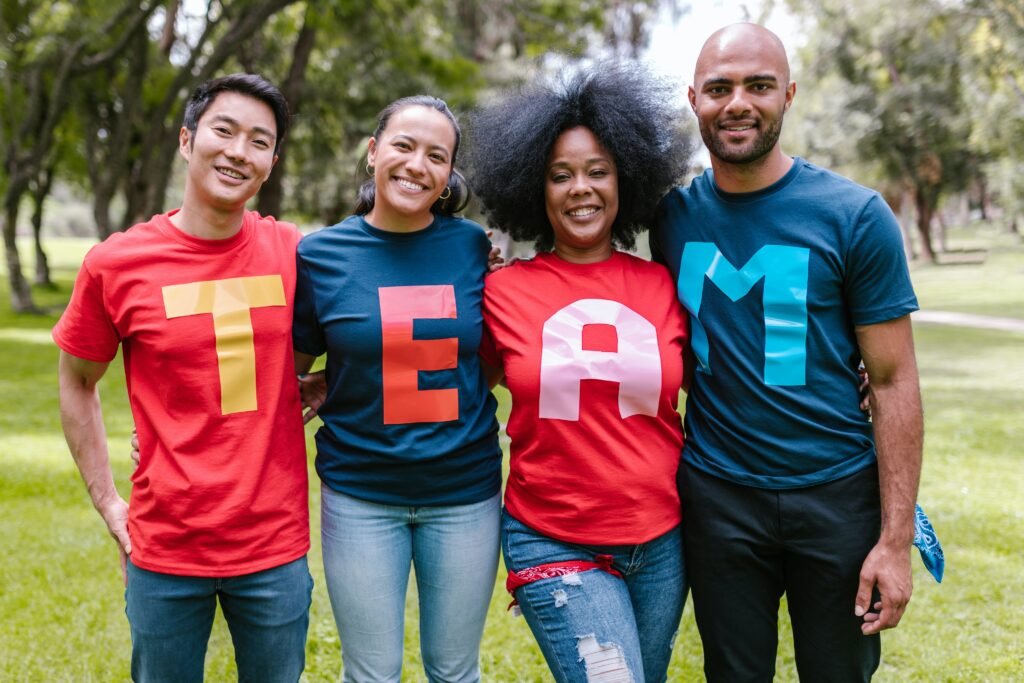In today’s evolving work environment, inclusive leadership has become essential. By implementing inclusive leadership tactics and strategies, organizations can promote diversity and create a more inclusive and productive workplace. Inclusive leadership involves nurturing relationships, enhancing communication, inspiring team members, providing constructive feedback, and fostering teamwork.
Key Takeaways
- Inclusive leadership promotes diversity and inclusion in the workplace.
- Nurturing relationships and building authentic connections are essential for inclusive leadership.
- Effective communication plays a crucial role in fostering an inclusive organizational culture.
- Inspiring team members and recognizing their unique skills drive higher performance.
- Promoting collaboration and teamwork creates a supportive environment where diversity is valued.
Inclusive Leadership Tactics for Modern Teams
Growing Meaningful Relationships for Inclusive Leadership
Building inclusive teams and creating an inclusive workplace requires strong leadership skills. One key aspect of inclusive leadership is the ability to grow meaningful relationships with team members. By establishing trust, open communication, and genuine connections, leaders can foster an environment where everyone feels valued and included.
Inclusive leaders demonstrate a genuine interest in getting to know their employees on a personal level. They take the time to learn about their backgrounds, experiences, and aspirations. This not only shows appreciation for the individuality of each team member but also allows leaders to understand and leverage their unique perspectives and strengths.
Open and honest communication is essential in building inclusive relationships. Inclusive leaders create a safe space where team members feel comfortable expressing their thoughts and ideas. They actively listen, value diverse viewpoints, and encourage everyone to contribute to team discussions.
Inclusion is not just about diversity numbers; it’s about creating a culture where everyone feels a sense of belonging and can thrive.
By prioritizing building connections and fostering a sense of belonging, inclusive leaders create an environment where diversity flourishes. Team members are more likely to contribute their unique ideas and perspectives, leading to innovative solutions and increased collaboration.
Furthermore, inclusive leadership skills contribute to higher employee engagement, satisfaction, and productivity. When team members feel seen, heard, and valued, they are more motivated to give their best and contribute to the success of the organization as a whole.
Creating an inclusive workplace starts with leaders who are committed to building meaningful relationships and fostering inclusion. By investing in inclusive leadership skills, organizations can create an environment where diversity is celebrated, and everyone can thrive.
Enhancing Communication for Inclusive Leadership
Effective communication plays a crucial role in promoting inclusive leadership within organizations. As an inclusive leader, I understand the importance of actively listening to my team members and creating a space where everyone feels heard and understood. By paying attention to both verbal and non-verbal cues, I can gain deeper insights into their thoughts and feelings.
I strive to foster clear and thoughtful communication within my team, ensuring that all voices are valued and respected. This creates an inclusive organizational culture where diversity thrives and everyone has an equal opportunity to contribute and succeed.
Furthermore, I believe that effective communication is a catalyst for growth and development. By providing opportunities for diversity training and leadership development, I empower my team members to enhance their communication skills and expand their perspectives. This not only benefits each individual but also contributes to the overall success of the organization.
Enhancing communication for inclusive leadership requires a combination of active listening, open dialogue, and fostering a safe and inclusive environment. It involves recognizing and valuing the diverse perspectives and experiences that each team member brings to the table.
“Inclusive leadership is not just about what you say, but how you listen and engage with others.” -Simon Sinek
To illustrate the impact of enhancing communication for inclusive leadership, consider the following table:
| Inclusive Communication Tactics | Benefits |
|---|---|
| Active Listening | – Improved understanding and empathy – Enhanced collaboration and team synergy |
| Open Dialogue | – Encourages diversity of thought – Facilitates innovative problem-solving |
| Safe and Inclusive Environment | – Increased trust and psychological safety – Boosted employee engagement and satisfaction |
By implementing these inclusive communication tactics, leaders can foster a culture of belonging and create an environment where every individual feels valued and included. This not only enhances teamwork and collaboration but also contributes to the overall success and growth of the organization.
Next, we will explore how inspiring team members plays a vital role in inclusive leadership.
Inspiring Team Members for Inclusive Leadership
An inclusive leader understands that every team member possesses unique skills and potential. By recognizing and leveraging these individual strengths, they unlock hidden talents and drive higher performance within the team. Inclusive leaders prioritize open discussions about inspiration and motivations, fostering a sense of alignment between individual aspirations and organizational goals.
Through their inclusive leadership styles and framework, leaders promote a culture of inclusivity and empowerment. They create an environment where team members feel valued and supported, encouraging them to bring their authentic selves to work. By promoting inclusivity in leadership, organizations can harness the full potential of their diverse teams and achieve remarkable outcomes.
Embracing Individuality
An inclusive leadership style celebrates and embraces the diversity of team members. Leaders recognize that each person brings a unique perspective, background, and set of experiences to the table. By leveraging this diversity, they create an environment that fosters innovation, creativity, and problem-solving.
Encouraging Collaboration
Inclusive leaders understand the importance of collaboration and teamwork. They actively promote a sense of belonging and create opportunities for collaboration among team members, enabling them to share ideas, insights, and solutions. By fostering a collaborative environment, leaders cultivate an inclusive culture where everyone’s contributions are respected and valued.
Providing Support and Development
Inclusive leaders prioritize the development and growth of their team members. They provide the necessary support, resources, and opportunities for individuals to enhance their skills and reach their full potential. Through mentorship, training programs, and professional development initiatives, leaders empower team members to thrive and succeed.
“Inclusive leadership is about creating an environment where everyone feels valued, heard, and inspired to be their best. By recognizing and leveraging the unique strengths of each team member, leaders can foster a culture of inclusivity and drive exceptional performance.” – [Insert Real Name]
To illustrate the impact of inclusive leadership, consider the following table showcasing the differences between inclusive and non-inclusive leadership styles:
| Inclusive Leadership | Non-Inclusive Leadership |
|---|---|
| Promotes diversity and inclusivity | Leads to exclusion and marginalization |
| Fosters collaboration and teamwork | Encourages competition and conflict |
| Embraces diverse perspectives | Values conformity and uniformity |
| Inspires and motivates team members | Undermines morale and engagement |
| Drives innovation and creativity | Stifles growth and innovation |
By adopting inclusive leadership practices, organizations can create a positive and empowering work environment that fosters collaboration, unlocks the full potential of their teams, and achieves sustainable success.
Promoting Collaboration and Teamwork through Inclusive Leadership
Inclusive leadership is all about fostering collaboration and teamwork within an organization. As an inclusive leader, I believe in constructing diverse teams that bring together individuals with different backgrounds, experiences, and perspectives. This diversity of thought and life experiences enhances problem-solving and drives innovation.
To promote collaboration, I ensure that materials and information are provided in advance, allowing team members to adequately prepare. This not only enables a more productive discussion but also ensures that everyone has an equal opportunity to contribute their ideas.
As an inclusive leader, I encourage risk-taking and foster an environment where team members feel comfortable expressing their opinions openly. This creates a space where diverse perspectives are valued, and everyone feels empowered to bring their whole selves to work.
Furthermore, I believe that inclusive leadership practices, training, and behaviors are crucial in creating a supportive environment where teamwork thrives. By investing in inclusive leadership training, organizations can equip their leaders with the necessary skills to foster collaboration, celebrate diversity, and build inclusive teams. Implementing inclusive leadership practices and behaviors not only enhances teamwork but also contributes to a culture of belonging, driving employee engagement and overall success.
FAQ
What are some inclusive leadership tactics for modern teams?
Inclusive leadership tactics include nurturing relationships, enhancing communication, inspiring team members, providing constructive feedback, and fostering teamwork.
How can building meaningful relationships contribute to inclusive leadership?
Building authentic relationships with team members creates trust, open communication, and a sense of belonging, promoting inclusivity within the team.
How does enhancing communication contribute to fostering an inclusive organizational culture?
Effective communication, which involves active listening and ensuring everyone’s voices are heard, promotes inclusivity in leadership and creates opportunities for diversity training and leadership development.
How can leaders inspire team members and promote inclusivity in leadership?
Inclusive leaders inspire team members by recognizing and leveraging their unique skills and potential, aligning individual aspirations with organizational goals, and promoting inclusivity through their leadership styles and framework.
How does inclusive leadership promote collaboration and teamwork?
Inclusive leadership practices, training, and behaviors create a supportive environment where teamwork thrives, diverse perspectives are valued, and inclusivity is prioritized.











